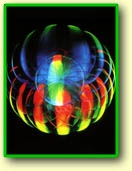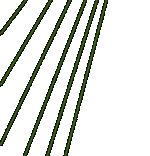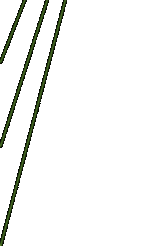Holographic
metaphor
B.O. Maier (maier@holography.ru).
 Contents Contents
Introduction
At present, such terms
as holistic approach, holistic trends, holistic breath, holistic thinking, holistic motion
(as a dynamic order model on subatomic level) etc. have become worldwide known. To our
opinion, these terms come from the term "hologram" that was invented by Nobel
laureate D. Gabor in 1949's. It referred to compact ho listic
recording of the information in the electronic microscopy and it based on the Greek word
"HOLOS" - "fullness", "wholeness". The
"introduction" of this term, based on the word "hologram", into
cultural everyday life has begun initially at the 60's after the work that was done on
optical holographs by American scientists E. Leigth and
J.Upatnieks and Russia scientist Uri N. Denisyuk
[1963]. That was connected to the "mystic" feeling that a watcher expressed in
the presence of some hologram. Such influence of a hologram is stipulated probably by the
fact that a hologram of some scene and the principle of holography itself are material
objects and the process that activate the archetypes of "Mandala",
"wholeness", "Self" - one of main layout elements of Psyche of a
person as a holistic phenomenon [K. G. Young].
The author was lucky to
study and work under Dr. Uri N. Denisyuk’s and his student D.I.
Staselko’s supervision during almost ten years. This work concerned the theoretical
and experimental problems of laser holography. By now it has become clear that the
occurrence of holography as a principle of displaying and reproduction information of
objects was not accidental in the middle of the XX century. It reflected the fact that
human beings started to realize the wholeness, fullness and general interconnections of
the world. In following years this understanding was also reflected in such seemingly
distant areas of knowledge as: bootstrap approach in the theoretical physicist of
elementary particles, transpersonal psychology [S. Grof], ecological motion "green
peace" etc. So the new social-scientific paradigm was shaped in 80-e years [Fr.
Capra]. The direct influence upon shaping this trends has been rendered personally by D.
Gabor, who reported in the Roman Club in early 70-s, and who then initiated and leaded the
studies of global modeling.
Initially American
scientists E. Leigth and J. Upatnieks, who studied the applied aspects of theory of
information, understood that with the use of the special types of light signals it is
possible to write information of the object on the typical photo plate. This way when
illuminating a photo plate there will be restored the light wave identical in its spatial
features to the light wave of the object on stage of recording. Three-dimensional illusion
of presence of the object is created for the watcher of the hologram. Simultaneously and
in parallel with the American authors Uri N. Denisyuk has formulated the
principles of a holographic recording of not only spatial but also simultaneously the
spectral (color) features of the objects. Uri N. Denisyuk has also accomplished
the experimental study. Hereinafter this type of holograms was named by the name of the
author – “ Denisyuk's holograms”.
Main idea
According to the
concept of analytical psychology [K. G. Young], one of the leading psychological patterns,
a layout subsets of human Psyche, is the archetype of the wholeness and fullness – a
pattern of wholeness of body, conscious and unconscious psychic functions of a person. In
the essence, this archetype reveals itself in the consciousness through the symbols of
"Mandala" as a square and / or cross. Generally speaking, it contains four
corners connected with the idea of circle. From this point of view, the phenomenon of
holography is a metaphor of the archetype of wholeness, "Self" [K. G. Young],
that was developed and demonstrated in the modern science and culture at our presence.
From this "psychological" point of view, a principle of hologram, originally
worded in the narrow section of physical optics, is now one of the first stages of modern
deployment of the human's collective unconscious. In the opinion of the author, at
present, the development of this process has brought about the shaping of
"holographic metaphors" that covers, as it was indicated, different areas of
knowledge. The pattern of wholeness in holography is sufficiently obvious, if we take into
consideration the basic ideas of optical holography, that were studied in the majority of
researches, as we see in history, and which are closely connected to the modern
expectations of new technologies:
"Fullness": "Distribution" -
"Associativity" - "Equivalence"
1.
"Fullness" of the recording of the information. The whole information
of the object is recorded on the carrier: the spatial structure, the spectral (color)
characteristics and the changing of the object that occur in time. Thereby, theoretically
the hologram allows to record all the information that the human analyzing eye uses for
orientation in the surround space.
2.
"Distribution" of stored information. Each small part of holograms
contains the complex information about the space and color parameters of the whole object.
Herewith, the bigger part of hologram is used for reconstructing of the object, than the
more exactly (more detailed) it is restored. Consequently, each small part of the hologram
contains presentation of the objects as a whole, but not exact.
3.
"Associativity" of the recording. If a part of the object, to be
recorded, is presented to the hologram on a stage of its reconstruction, it
restores all the lacking parts of the object. As theoretical work and experimental
modeling have shown, it is possible to create rather complex sequences of associatively
bound images via combining the information of several objects in one hologram.
4.
"Equivalence" of hologram and object. According to modern scientific
views, objects reveal themselves in the world through their interactions in the manner of
different floors [D. Bohm]. If the whole complex of floors diffused by the object is
reproduce dynamically, the watcher won’t distinguish the image and the object. In a way,
a material copy of the object appears. This copy will be even more exact if the whole
volume of radiation, diffused by the object, is recorded and used when reproducing a
hologram. The principle that hologram is equivalent and is a material copy of object, was
first formulated in the works of Uri N. Denisyuk [1963].
The joint consideration
of the "distribution" of stored information and "equivalence" of
hologram and object brings about a well-known metaphor: "A drop of water contains the
whole ocean". Or at the opposite: the cited metaphor applied to the holography sounds
as following: "Both the distribution and equivalence". The joint research of
"fullness" of the record and of associative coherence leads to the idea of
investigation of the "ocean on the separate drop", at least in general.
These two metaphors are
linked into the holographic metaphor of the fullness, interconnection of the surrounding
world, including people; a metaphor of the possibility of cognition of the whole in a part
and of the endless process of "revision" on this way. So, probably, it is
possible to formulate the holographic metaphor as the following: "both fullness and
associative coherence, on the one hand, and distribution and equivalence, on the other”.
In result we get wholeness in accumulation (recording), reproducing and handling of
information. In this case the wholeness in the "Square" is simultaneously a
source and a counterweight of the three sides: distribution, equivalence and
associativity.-->
|





